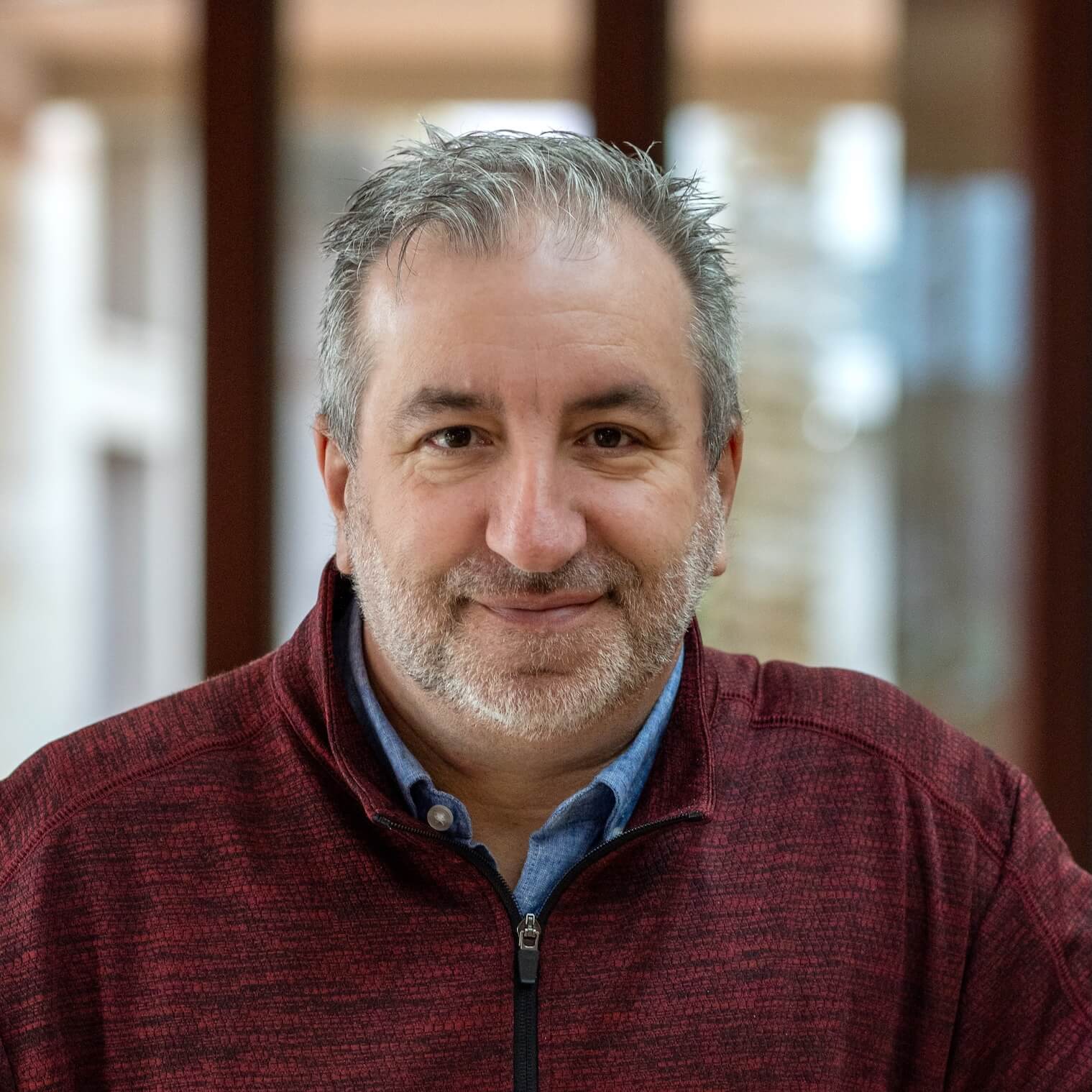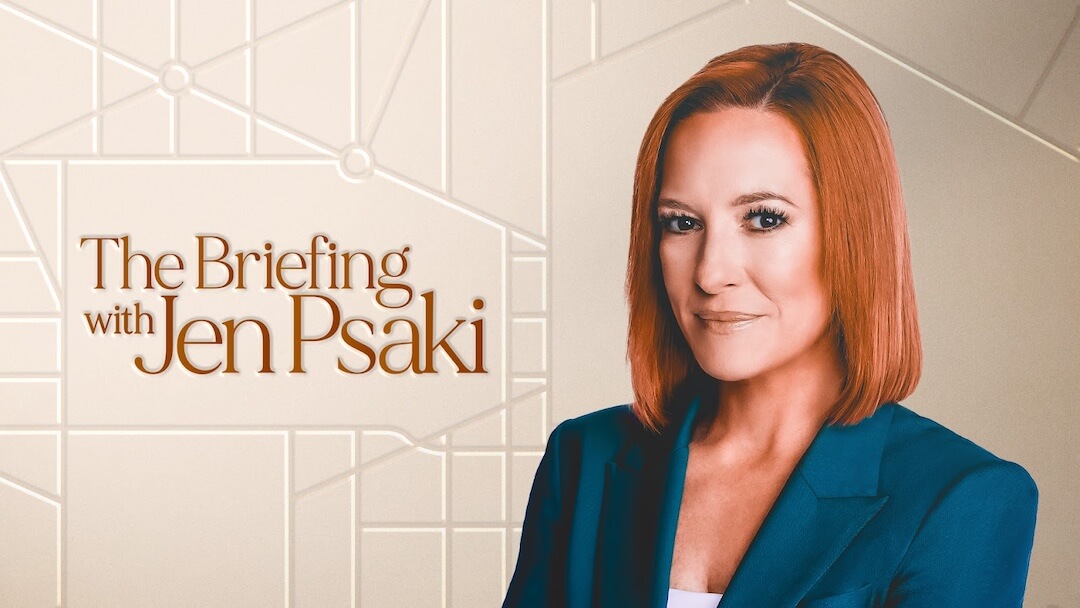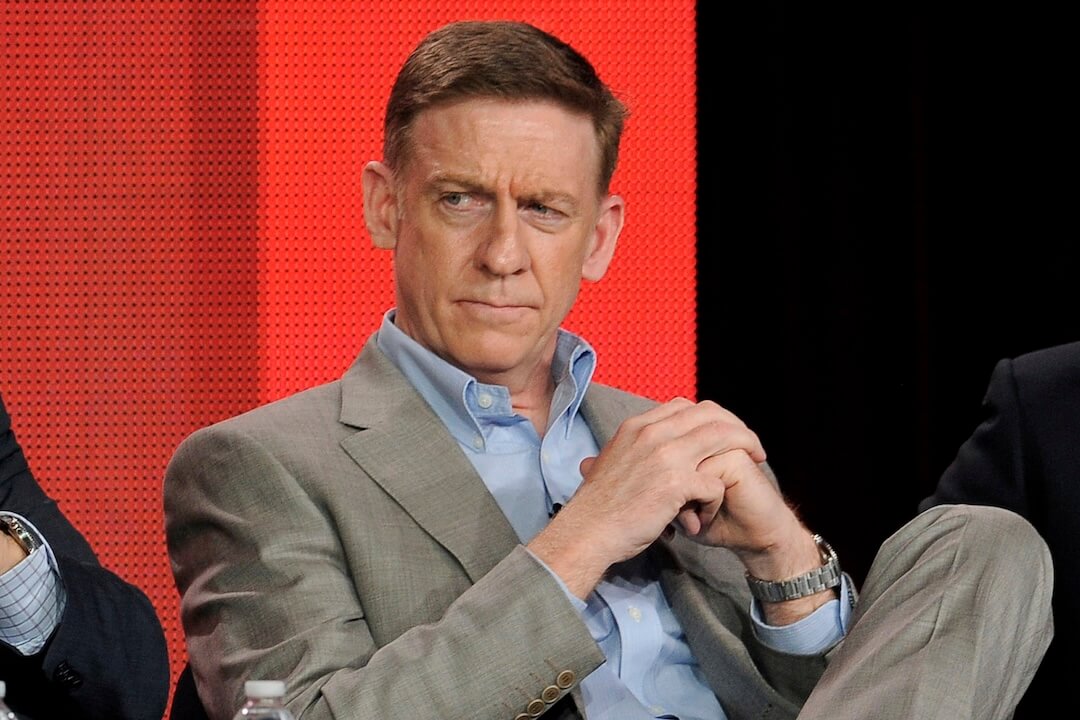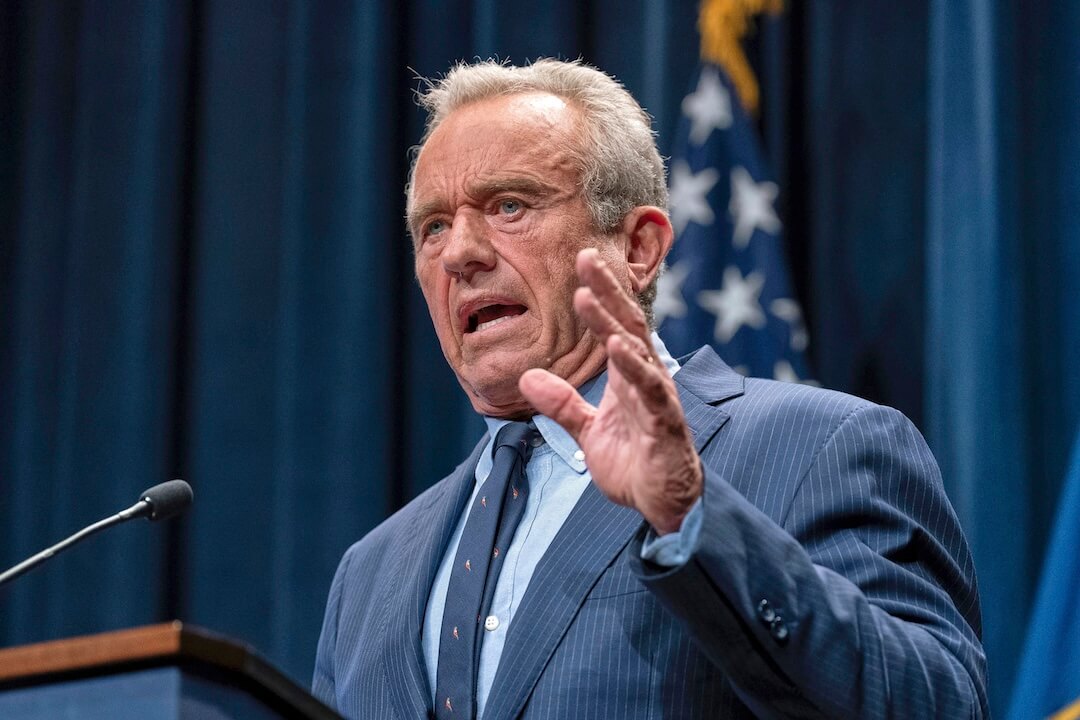One year.
That’s how long the United States has essentially been shut down because of COVID-19. March 11, 2020 — one year ago Thursday — is the date many will point to as when everything froze. That’s when the coronavirus officially became a pandemic, according to the World Health Organization. To commemorate the anniversary, President Joe Biden addressed the nation in a primetime speech.
Certainly, a year ago, we were generally aware of the potential of stormy clouds on the horizon. But many had no idea of what was truly ahead. Predictions that we would all return to normal by July or August 2020 were wildly optimistic and not even close to realistic. They now seem almost childish in their wishful thinking. Fast-forward to today and July or August 2021 might be a little too hopeful.
And, of course, worst of all, we could not fathom that more than half a million people in the U.S. would die.
It has been a year, but in some ways, it’s hard to remember what life was like before COVID-19 — when we could walk around without masks, go to concerts, go out to eat, go to ball games. Or do even the basics like grocery shop or get a haircut or send our kids to school without worrying about the consequences.
Over the past year, new words and new phrases and new things have become a part of our everyday lives and conversations. Words like coronavirus, Zoom, social distancing, herd immunity.
A presidential election might have been swung because of how COVID-19 was handled. And we became familiar with people such as Dr. Anthony Fauci and Dr. Sanjay Gupta.
So I wanted to take a few moments to highlight a few stories that recognize the past year.
I start by quoting from The Washington Post’s latest project from Reis Thebault, Tim Meko and Junne Alcantara. Here’s how their latest begins:
For most people, March 11 was when the COVID-19 crisis first became real. It was the day of a high-profile diagnosis, major event cancellations and an official designation: pandemic. Schools closed, streets emptied and commuters stayed home.
We didn’t know it then, but the virus already had infected thousands of Americans. Scientists developed vaccines in record time. Misinformation and lies spread as quickly as the pathogen itself. Racial and economic inequalities compounded. A new president was elected.
Over the next 12 months, leaders bungled opportunities to quell its spread, case levels rose, fell and rose again, hope endured, and more than 525,000 people lost their lives.
The project — called “Sorrow and stamina, defiance and despair. It’s been a year.” — collected and analyzed data over the past year to, according to a Post spokesperson, “map every death from COVID-19, showing the waves of loss the country has endured, and their severity, through month-to-month animation.”
It’s a superb and well-produced piece, certainly worth your time.
Meanwhile, BuzzFeed News talked to more than 60 people for “March 11.” It’s an oral history that revisits March 11 of last year — the day Broadway went dark and sports started to shut down. Interviews include Dr. Anthony Fauci, Chet Hanks, Cy Vance, Rosanna Arquette, Gloria Allred, Rose McGowan, Ed Bastian, Mark Cuban, Mark Tatum, Chris Hayes, Corey Johnson, and many others.
Here are some more stories as we acknowledge one year of a pandemic:
- Rachel Schallom and the staff of Fortune with “One year later: 15 ways life has changed since the onset of the COVID pandemic.”
- CNN’s Brian Stelter with “The US pandemic at one year: Looking back at the week everything changed, and looking forward.”
- NPR’s Laurel Wamsley with “March 11, 2020: The Day Everything Changed.”
- Writing for Esquire, Jeff Sharlet with “All That We’ve Lost.”
- Rolling Stone’s Brian Hiatt with “The Damage Done: Looking Back At A Year Without Concerts.”
- Vox has collected all of its stories for “One Year Later.”
- And finally, a collection of stories from The New York Times as it looks back at a year of loss and disruption.
Good guest
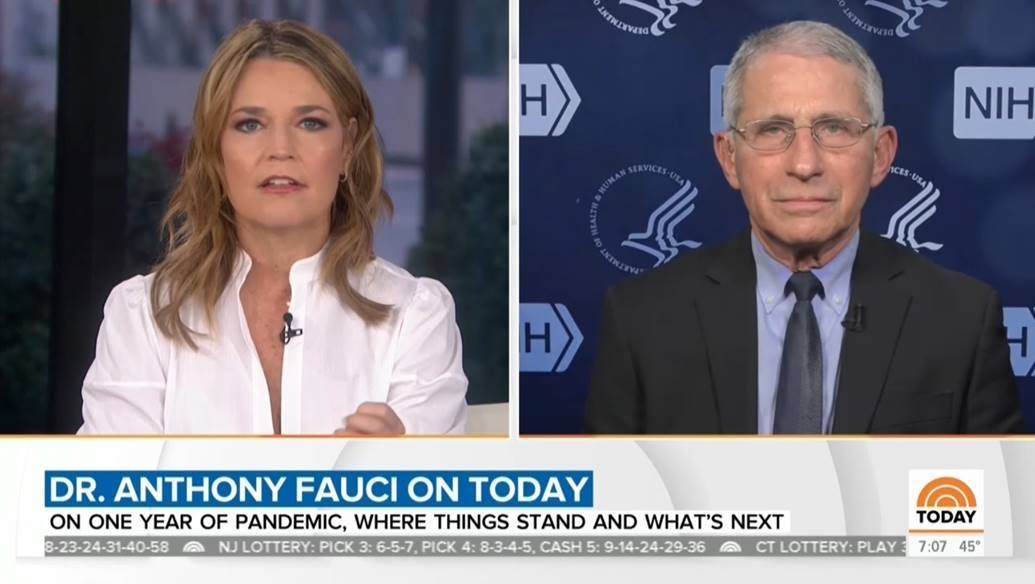
NBC News’ Savannah Guthrie interviewing Dr. Anthony Fauci on Thursday’s “Today” show. (Courtesy: NBC News)
Dr. Anthony Fauci was a guest on Thursday morning’s ESPN show “First Take” with Stephen A. Smith, Max Kellerman and Molly Qerim Rose. This was a smart move — by Fauci and by the show. This was a chance for Fauci to reach a younger audience to talk about the importance of getting vaccinated, as well as the necessity to keep practicing things such as wearing masks and social distancing.
Fauci also addressed the impact COVID-19 has had on Black and Hispanic communities and why it’s important that members of those communities get vaccinated, while acknowledging the skepticism that many Black people have when it comes to vaccinations. (The New York Times’ Sheera Frenkel addressed this topic in her story: “Black and Hispanic Communities Grapple With Vaccine Misinformation.”)
Fauci also talked about what a so-called “return to normalcy” might look like and when that is possible.
Fauci has made guest appearances on a wide variety of shows and platforms and Thursday was another example of making an appearance to get in front of more Americans. Good for him for going on “First Take” and good for “First Take” for having him on.
Fauci also appeared Thursday in a setting we’re more familiar with: the “Today” show. He told co-host Savannah Guthrie that it’s “risky” that Texas is reopening so quickly.
“We’ve got to be careful,” Fauci said. “At minimum, people need to continue to wear masks.”
Fauci also told Guthrie what he thought went wrong during the pandemic and it was nothing even mildly surprising: “We had such divisiveness in our country that even simple commonsense public health measures took on a political connotation (with) people.”
[the_ad id=”667826″]
‘COVID will be with us for some period of time’
While many of us are hoping there is light at the end of the tunnel when it comes to COVID-19, Centers for Disease Control and Prevention director Rochelle Walensky was still pumping the brakes during an interview with Lester Holt on Thursday’s “NBC Nightly News.”
Walensky told Holt, “COVID will be with us for some period of time. … I think we are going to have to learn to live with it, that we will have COVID, cold and flu season for some period of time, and that we have a lot more science that we have to learn about this disease.”
She said this month and next are “such important critical times.”
“On the one hand you have this hyper-transmissible virus that could result in more, in another surge after spring break, after people are really interested in traveling and after people have opened up their communities,” Walensky said, “On the other hand, we are scaling up vaccinations so very fast. … So it’s going to be those two forces working against one another, which is why we really want the vaccine force to win.”
Calling out Fox News
Washington Post media writer Jeremy Barr has a new piece that points out the hypocrisy at Fox News in “Fox News wants you to wear a mask. The network’s top stars want to ridicule them.”
Barr writes, “some of the network’s top personalities seem to be undermining” the message that people should wear masks.
I mentioned in my newsletter earlier this week that Fox News anchor Martha MacCallum, considered one of the network’s straight news people (as opposed to its primetime pundits), questioned masks when she said on air, “I always think we’re going to look back at these studies and wonder about the true effectiveness of masks and whether they really did make a difference.”
Barr also mentioned MacCallum’s comments, as well as pointing out questionable comments about masks made by Tucker Carlson and contributor Tomi Lahren, who calls masks “face diapers.”
In a statement to Barr, Fox News said, “Fox News Media has continuously provided viewers with the latest news on the global pandemic over the past year, hosting over a dozen pandemic-related town halls, while extensively promoting mask-wearing and vaccinations to our audience via public service announcements across all platforms. Any suggestion otherwise is pure cherry-picking and a deliberate mischaracterization of the facts.”
[the_ad id=”667872″]
Speaking of Tucker Carlson …
On his show this week, Carlson commented on President Biden saying the United States military had designed uniforms to fit women properly, created maternity flight suits and updated hairstyle requirements. Carlson said, “So we’ve got new hairstyles and maternity flight suits. Pregnant women are going to fight our wars. It’s a mockery of the U.S. military.”
Now Carlson is getting pushback. CNN’s Oliver Darcy and Barbara Starr write, “Pentagon and senior members of military call out Tucker Carlson for mocking women serving in armed forces: His words ‘don’t reflect our values.’”
Media tidbits

Someone in London watching Oprah Winfrey’s interview with Prince Harry and Meghan, Duchess of Sussex. (Photo: zz/KGC-254/STAR MAX/IPx)
- In case you missed it or want to watch it again, Oprah Winfrey’s interview with Prince Harry and Meghan, Duchess of Sussex, will air again tonight at 8 p.m. Eastern on CBS.
- Mary Margaret has been named editor-in-chief at Entertainment Weekly, becoming the EW’s first female editor-in-chief. Variety’s Todd Spangler has more on Margaret.
- The New York Post has hired Ian O’Connor as a sports columnist. O’Connor is top-notch and it’s good to see him land a high-profile gig after being among the cuts at ESPN late last year. In addition to his longtime work at ESPN, O’Connor has written several books and has been a sportswriter at the New York Daily News, The Bergen Record, USA Today and The Journal News.
- In a note to staff, CNN president Jeff Zucker said he hopes staffers in news and sports can return to the Atlanta headquarters on Aug. 1. He is hoping those at CNN in New York, Washington, D.C., Los Angeles and San Francisco can return by Sept. 1.
- Awful Announcing’s Joe Lucia looks at the new NHL TV deal in “Winners and losers of the NHL’s TV deal with ESPN.”
Hot type
- Writing for MIT Technology Review, Karen Hao with “How Facebook got addicted to spreading misinformation.”
- Video from NPR: “The Early Days Of The Pandemic As Seen Through Your Camera Roll.”
- The New York Times’ Katherine Rosman and Reggie Ugwu with “What Really Happened at ‘Reply All’?”
Have feedback or a tip? Email Poynter senior media writer Tom Jones at tjones@poynter.org.
[the_ad id=”667878″]
More resources for journalists
- Subscribe to Alma Matters – Poynter’s new newsletter for college journalism educators
- Professor’s Press Pass (Poynter) — Get access to a growing library of case studies
- Diversity Across the Curriculum (Online Seminar) — Apply by March 19
- Becoming a More Effective Writer: Clarity and Organization (Online Seminar) — April 5-30
The Poynter Report is our daily media newsletter. To have it delivered to your inbox Monday-Friday, sign up here.


